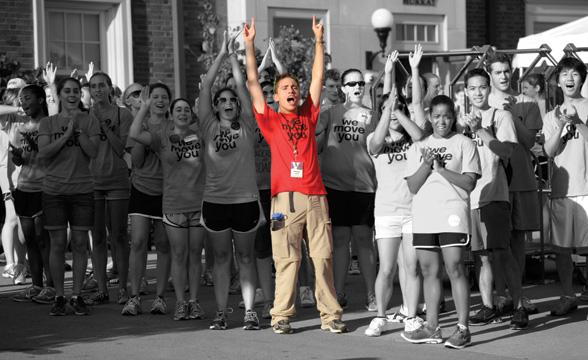I did what I think many of us did when starting this assignment.

I started opening tabs and tabs and tabs when I mistakenly clicked on the “Images link” on top of my window and discovered various shots of Michael. I wonder, would I know Michael if I saw pictures of him or read what other told about him. Does the web encapture who we are through quotes and snapshots of our lives or is it just a nice story book.

This pictures was taken a few years ago in Nashville, Tennessee where Michael went for a concert with his good friend Jessie. He had won two tickets to go see and hear Yo-Yo Ma play with the Nashville Symphony Orchestra. Other than the fact that Yoyoma “played like he had a demon inside him and that he was releasing it through the tip of his bow”, this picture is also used as the face of Michael on numerous websites such as LinkedIn and Twitter.
Michael first encountered Twitter through a high school class on media in the 21st century. After exploring this new form of media, he could not figure out a meaningful way to use it until a few months ago when he discovered the importance of Twitter in the media world. Twitter happens to be a great tool for surfacing information on subjects that Michael likes and follows but also for networking purposes. He discovered that Twitter acts a bit like a “social currency” amongst journalists. Following someone or being followed are not traded lightly in an industry where validation of peers seems important.

Look at that smile! This one was taken during Michael’s senior high school year as part of all the pictures taken for the YearBook and other internal school publications. This picture is actually the journalist face of Michael. It was primarily used as profile picture for the New-York Time blog. Michael wrote articles for the New York Times between March and June 2010. He was among 6 students who were selected to write about their college admission process in the NYT blog.
Michael journalistic interest did not start at the New York Times. He was Co-opinion and then Co-editor of his high school newspaper. He really enjoys writing and despite not being ready to commit to journalism, he knew that he was not done with it either. His take on this experience at the New York Times: “crazy”, “bizarre” and “fascinating”. He was impressed that so many people were invested in his story, and yet that the journalist’s work creates a “layer of abstraction” that put some distance from the reality of the people in the pieces and ease to write about anyone.

This third one is a treacherous one: the picture was edited and used in a very different context than the actual one in which the picture was taken. Let’s talk about the picture first. This was taken in sophomore year at Vanderbilt when Michael was “Vuceptor” Vuceptors are the older students dedicated to helping new students and their parents settled so they don’t have to lift a thing.
The trick here is that the picture was trimmed and Michael was put in the for front. Instead of seeing the load of other students helping and the queue of cars with parents eager to get their offspring settled in, the picture was edited and linked to a piece on the Vanderbilt blog talking about the One who chose Vanderbilt over Yale a few years ago and its evolution at Vanderbilt. Michael knows this is mainly because “Vanderbilt was excited I had picked them over Yale” but this piece, following the story the NYT started on him, was really “disconnected from the reality” and deciding for “college gets too many people stressed”. The one thing Michael wants us to remember from this picture is that “he was happy to be at Vanderbilt”.

Lastly I asked Michael about this picture. He remembered most of the context. This is an extract of a Vanderbilt TV coverage of an annual concert organized in Nashville for students. This particular concert was in 2012, Archives Nights were playing. Michael remembers a “great concert” and the 4 members of the band “were good”. He confessed that he had tried to organize a similar event to promote the band and it ended up being “a terrible event that he had tried to plan”.
After all of this, I asked Michael if this glimpse of what could be found on him on the internet was a good representation of who he was. He paused for a while and admitted that it was “incomplete”. The public content is mostly “polished and professional”, more of a “candid shot” and that none of the pictures or the articles attached were “capturing the true sense of everyday”. For him, his Facebook profile would give a better representation of who he is but even a privileged access on his social media profile would still not do the trick.
Most pictures present have been posted by friends rather than himself. An interesting thought crossed my mind. The absence of pictures of Michael was perhaps more representative of him than what you could actually find. After sharing this thought with him he concluded: “In a lot of sense I’m boring. I don’t put myself in position where people would take picture and I would be embarrassed in they posted them online”. This struck me. First, it would mean that not ending on Facebook in some weird half-naked outfit is boring. Second and more importantly, you obviously don’t end up writing for the New York Times or studying at MIT by being boring. Maybe there is more to it than meet the eye and the digital world is far from being mature to represent lives and share experiences.










